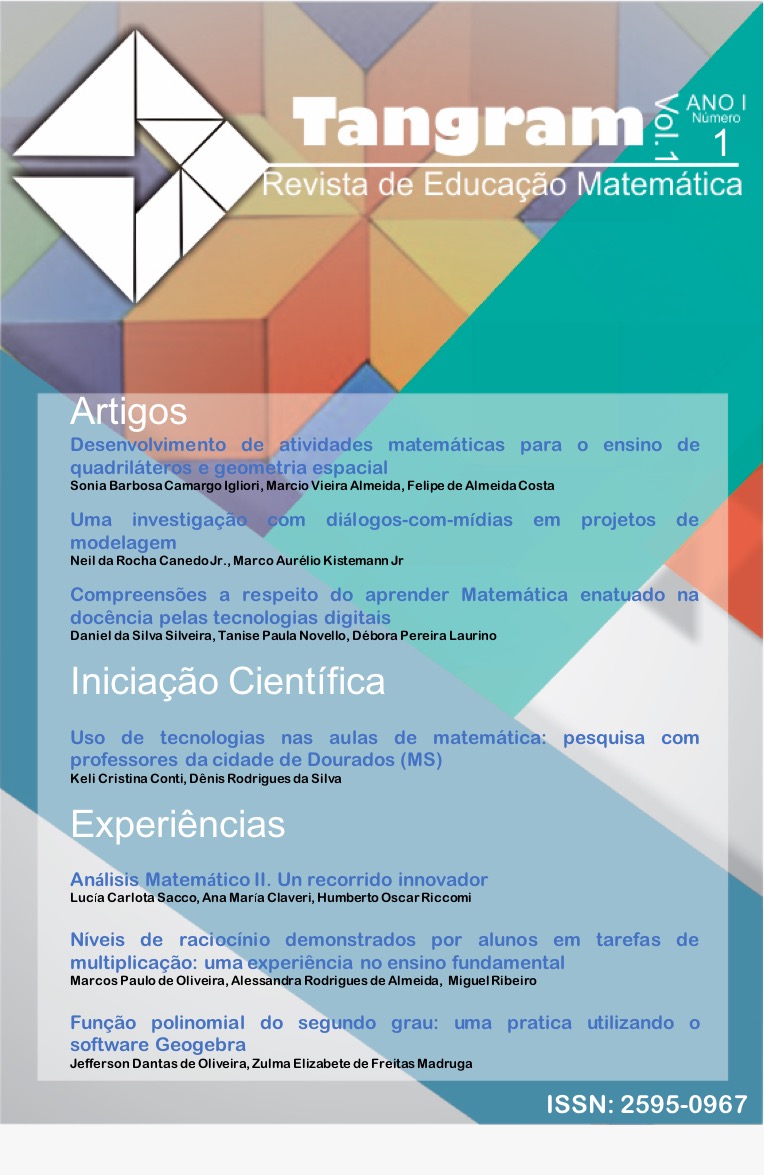Desenvolvimento de atividades matemáticas para o ensino de quadriláteros e geometria espacial
DOI:
https://doi.org/10.30612/tangram.v1i1.7306Keywords:
Ensino Fundamental, Ensino de quadriláteros, Ambiente digitalAbstract
Neste artigo são apresentadas dois conjuntos de atividades para o ensino da Matemática produzidas com o auxílio do GeoGebra. Elas se inserem no âmbito do projeto de pesquisa intitulado Atividades Matemáticas para o Ensino Fundamental II no ambiente WordPress. Neste artigo são detalhados os objetivos do projeto, sendo que um deles é desenvolver e fornecer atividades para auxiliar os professores em suas aulas de matemática, e apresentar os referenciais teóricos e metodológicos que subsidiam o projeto e o desenvolvimento de cada conjunto de atividades. Definimos neste trabalho apresentar atividades para o ensino de quadriláteros, essas são respaldadas por constructos teóricos da Aprendizagem Significativa de Ausubel, dos níveis de desenvolvimento do pensamento geométrico de Van Hiele e da noção de organizador genérico de Tall. Ao final indicamos os próximos passos do projeto e os procedimentos esperados com as atividades apresentadas.Downloads
References
Abar, C.A.A P.; Igliori, S.B.C. (2012) Coleção. A reflexão e a prática de ensino. Matemática. vol. 4, Editora Edgard Blucher.
Ausubel, D. P. (2003) Aquisição e Retenção de Conhecimentos: uma perspectiva cognitiva. Lisboa: Paralelo. Tradução de: Ligia Teopisito.
Ausubel, D. P.; Novak, J. D.; Hanesian, H. (1980) Educational psychology. New York: Holt, Rinehart and Winston. Publicado em português pela Editora Interamericana, Rio de Janeiro, 1980. Em espanhol por Editorial Trillas, México, 1981. Reimpresso em inglês por
Werbel & Peck, New York.
Bicudo, I. (2009 )Os Elementos de Euclides (tradução e introdução). São Paulo, Editora UNESP, 593 p.
Rogers, E. M. (2003)Diffusion of Innovations. 5th ed. New York: Free Press.
Rommevaux, M. L. (1997) Le discernement des plans: um seuil décisif dans l’apprentissage de la géométrie tridimensionnelle. Strausbourg, France: Université de Soutenance.
Tall, D. (1986) Building and Testing a Cognitive Approach to the Calculus Using Interactive Computer Graphics. 1986. 505 f. Tese (Doutorado em Educação Matemática) – University of Warwick, Inglaterra.
Tall, D. (1989) Concept images, computers, and curriculum change. For the Learning of Mathematics, v 9, n 3, p. 37 – 42.
Tall, D. (2000) Biological Brain, Mathematical Mind & Computational Computers (how the computer can support mathematical thinking and learning). In: ASIAN TECHNOLOGY CONFERENCE IN MATHEMATICS, 5, Chiang Mai. Proceedings... Blackwood: ATCM Inc,. Disponível em: http://homepages.warwick.ac.uk/staff/David.Tall/pdfs/dot2000h-plenary-atcm2000.pdf. Acesso em 22 jan. 2013.
Van Hiele, P. M.(1986) Structure and insight. Orlando: Academic Press.
Villiers, M. (2010) Algumas reflexões sobre a teoria de Van Hiele. Tradução Celina A. A. P. Abar. Educação Matemática Pesquisa, v. 12, n. 3, p. 400 – 431, 2010.
Downloads
Published
How to Cite
Issue
Section
License
Copyright (c) 2018 TANGRAM - Revista de Educação Matemática

This work is licensed under a Creative Commons Attribution-NonCommercial-ShareAlike 3.0 Unported License.
Authors must accept the publication rules when submitting the journal, as well as agree to the following terms:
(a) The Editorial Board reserves the right to make changes to the Portuguese language in the originals to maintain the cultured standard of the language, while respecting the style of the authors.
(b) Authors retain the copyright and grant the journal the right to first publication, with the work simultaneously licensed under the Attribution-NonCommercial-ShareAlike 3.0 Brazil (CC BY-NC-SA 3.0 BR) that allows: Share - copy and redistribute the material in any medium or format and Adapt - remix, transform, and create from the material. CC BY-NC-SA 3.0 BR considers the following terms:
- Attribution - You must give the appropriate credit, provide a link to the license and indicate whether changes have been made. You must do so under any reasonable circumstances, but in no way that would suggest that the licensor supports you or your use.
- NonCommercial - You may not use the material for commercial purposes.
- Sharing - If you remix, transform, or create from material, you must distribute your contributions under the same license as the original.
- No additional restrictions - You may not apply legal terms or technological measures that legally restrict others from doing anything that the license permits.
(c) After publication, authors are allowed and encouraged to publish and distribute their work online - in institutional repositories, personal page, social network or other scientific dissemination sites, as long as the publication is not for commercial purposes.






